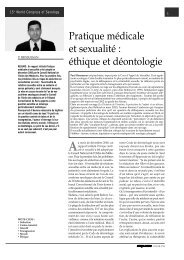Événements de vie et anxiété chez les hommes souffrant de ...
Événements de vie et anxiété chez les hommes souffrant de ...
Événements de vie et anxiété chez les hommes souffrant de ...
Create successful ePaper yourself
Turn your PDF publications into a flip-book with our unique Google optimized e-Paper software.
12<br />
Anxi<strong>et</strong>y<br />
We studied the general and stable form<br />
of anxi<strong>et</strong>y experienced by individuals<br />
that <strong>de</strong>fines the way in which they<br />
cope with outsi<strong>de</strong> events. According<br />
to the mo<strong>de</strong>l <strong>de</strong>veloped by Rahe<br />
(1976), psychologically-strong individuals<br />
experience events for a shorter<br />
period of time than more fragile individuals,<br />
thereby avoiding the accumulated<br />
impact of successive events.<br />
We also investigated performance<br />
anxi<strong>et</strong>y, often mentioned by the<br />
authors as a factor that could lead to<br />
erectile disor<strong>de</strong>rs. Masters and Johnson<br />
(1971) suggested a possible<br />
mechanism of cognitive interference,<br />
often referred to as the “vicious circle<br />
of anxi<strong>et</strong>y”, where the fear of failure<br />
accumulates with the anxi<strong>et</strong>y, to establish<br />
the erectile disor<strong>de</strong>r.<br />
Some research conducted by Hartmann<br />
(1998) evi<strong>de</strong>nced the role of performance<br />
anxi<strong>et</strong>y in the ons<strong>et</strong> of erectile<br />
disor<strong>de</strong>rs. The author i<strong>de</strong>ntified<br />
three main factors in patients, which<br />
he suggests should be consi<strong>de</strong>red as<br />
a continuum:<br />
- Immediate factors represented by<br />
the performance anxi<strong>et</strong>y,<br />
- Life events in the patient’s recent<br />
past,<br />
- Constitutional vulnerability acquired<br />
in childhood.<br />
We therefore formulated the following<br />
hypothesis:<br />
H3: individuals suffering from erectile<br />
disor<strong>de</strong>rs have significantly high<br />
anxi<strong>et</strong>y levels.<br />
■ M<strong>et</strong>hodology<br />
We used the State-Trait Anxi<strong>et</strong>y Inventory<br />
or STAI <strong>de</strong>veloped by Spielberger<br />
(1983). This tool provi<strong>de</strong>s an in<strong>de</strong>pen<strong>de</strong>nt<br />
assessment of the anxi<strong>et</strong>y trait<br />
which makes reference to stable and<br />
specific characteristics of the state of<br />
anxi<strong>et</strong>y related to a situation, or an<br />
event. We therefore wanted to make<br />
a more specific assessment of the<br />
general state of anxi<strong>et</strong>y using the traitanxi<strong>et</strong>y<br />
scale and performance anxi<strong>et</strong>y<br />
using the state-anxi<strong>et</strong>y scale.<br />
Results<br />
■ Distribution of life events<br />
There was an accumulation of life<br />
- VOL.XIII, N°49<br />
events during the year prior to the<br />
ons<strong>et</strong> of the erection disor<strong>de</strong>r. This<br />
peak of events was also observed in<br />
the control subjects, but to a <strong>les</strong>ser<br />
extent (Figure 1/see french version).<br />
In the patients, there was a 200%<br />
increase in events experienced during<br />
the year prior to t0, compared to only<br />
69 % for the control subjects (Table<br />
1/french version). And y<strong>et</strong>, the patients<br />
did not give a significantly higher<br />
impact score to the events they experienced<br />
during the year prior to the<br />
ons<strong>et</strong> of erectile disor<strong>de</strong>rs than to the<br />
events they had experienced previously<br />
(Table 2/french version).<br />
■ The areas concerned<br />
by the life events<br />
Most of the events represented belong<br />
to the emotional field. (Figure 2, Table<br />
3/french version). In addition, the<br />
patients gave a high impact score to<br />
80.8% of the “emotional” type events<br />
they experienced (Table 4/french<br />
version).<br />
■ Type of life events<br />
The results show that the patients<br />
reported more events representing a<br />
loss (84.5%) than the controls (72.8%),<br />
and vice versa, the controls reported<br />
more events representing a gain<br />
(27.1%) than the patients (15.4) (Figure<br />
3, Table 5/french version). Furthermore,<br />
both the patients and the controls<br />
reported a stronger impact for events<br />
representing a loss than those representing<br />
a gain (Table 6/french version).<br />
■ Anxi<strong>et</strong>y<br />
As far as anxi<strong>et</strong>y is concerned, no<br />
significant differences can be seen b<strong>et</strong>ween<br />
the anxi<strong>et</strong>y scores obtained by<br />
the patients and those obtained by the<br />
anxi<strong>et</strong>y controls. (Table 7/french<br />
version).<br />
Conclusion<br />
The results obtained would seem to<br />
confirm hypothesis 1. As stated by<br />
Aharonian <strong>et</strong> coll. (1991) in their<br />
research, it would appear that the<br />
accumulation of events is an important<br />
factor in the role played by life<br />
events in the pathogenesis of erectile<br />
disor<strong>de</strong>rs. Furthermore, it would<br />
appear that even if the events are not<br />
judged to have a particularly strong<br />
impact on the subject, they neverthe<strong>les</strong>s<br />
have an accumulated effect.<br />
Concerning hypothesis 2, it would<br />
appear in fact that there is a type of<br />
event which plays in favour of the<br />
ons<strong>et</strong> of erectile disor<strong>de</strong>rs, i.e. events<br />
of an emotional nature and events<br />
representing a loss for the subject. The<br />
event most commonly mentioned is<br />
“separation/divorce”. This observation<br />
gives us an indication of the important<br />
role played by the relationship within a<br />
couple and the consequences of<br />
modifications to the balance in the<br />
couple in the ons<strong>et</strong> of an erectile<br />
disor<strong>de</strong>r.<br />
The results obtained from the anxi<strong>et</strong>y<br />
questionnaire do not point in the same<br />
direction as those obtained by Hartmann<br />
(1998) since we did not observe<br />
a high anxi<strong>et</strong>y level in the patient<br />
group. We are therefore unable to evi<strong>de</strong>nce<br />
the presence of performance<br />
anxi<strong>et</strong>y in men suffering from erectile<br />
dysfunctions; hypothesis 3 has not<br />
been evi<strong>de</strong>nced. However, it is possible<br />
that the STAI (Spielberger, 1983)<br />
is not a good tool to measure vulnerability<br />
to outsi<strong>de</strong> events, or even performance<br />
anxi<strong>et</strong>y. There are other measurement<br />
sca<strong>les</strong>, coping sca<strong>les</strong> which<br />
could provi<strong>de</strong> b<strong>et</strong>ter results. In addition,<br />
the fear of failure could be assessed<br />
by measuring self-esteem.<br />
Adresse pour correspondance :<br />
M. Bonierbale<br />
CHU Ste-Marguerite,<br />
Service du Pr C. Lançon,<br />
13274 Marseille Ce<strong>de</strong>x 9.<br />




